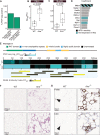This is a preprint.
Validation of a murine proteome-wide phage display library for the identification of autoantibody specificities
- PMID: 37066405
- PMCID: PMC10104109
- DOI: 10.1101/2023.04.07.535899
Validation of a murine proteome-wide phage display library for the identification of autoantibody specificities
Update in
-
Validation of a murine proteome-wide phage display library for identification of autoantibody specificities.JCI Insight. 2023 Dec 8;8(23):e174976. doi: 10.1172/jci.insight.174976. JCI Insight. 2023. PMID: 37934865 Free PMC article.
Abstract
Autoimmunity is characterized by loss of tolerance to tissue-specific as well as systemic antigens, resulting in complex autoantibody landscapes. Here, we introduce and extensively validate the performance characteristics of a murine proteome-wide library for phage display immunoprecipitation and sequencing (PhIP-seq), to profile mouse autoantibodies. This system and library were validated using seven genetic mouse models across a spectrum of autoreactivity. Mice deficient in antibody production (Rag2-/- and μMT) were used to model non-specific peptide enrichments, while cross-reactivity was evaluated using anti-ovalbumin B cell receptor (BCR)-restricted OB1 mice as a proof of principle. The PhIP-seq approach was then utilized to interrogate three distinct autoimmune disease models. First, serum from Lyn-/- IgD+/- mice with lupus-like disease was used to identify nuclear and apoptotic bleb reactivities, lending support to the hypothesis that apoptosis is a shared origin of these antigens. Second, serum from non-obese diabetic (NOD) mice, a polygenic model of pancreas-specific autoimmunity, enriched peptides derived from both insulin and predicted pancreatic proteins. Lastly, Aire-/- mouse sera were used to identify numerous auto-antigens, many of which were also observed in previous studies of humans with autoimmune polyendocrinopathy syndrome type 1 (APS1) carrying recessive mutations in AIRE. Among these were peptides derived from Perilipin-1, a validated autoimmune biomarker of generalized acquired lipodystrophy in humans. Autoreactivity to Perilipin-1 correlated with lymphocyte infiltration in adipose tissue and underscores the approach in revealing previously unknown specificities. These experiments support the use of murine proteome-wide PhIP-seq for antigenic profiling and autoantibody discovery, which may be employed to study a range of immune perturbations in mouse models of autoimmunity.
Keywords: PhIP-seq; antibody reactivity; autoimmunity; mouse proteome.
Conflict of interest statement
No potential conflicts of interest relevant to this article were reported.
Figures




References
-
- Anderson M. S., et al. , Projection of an Immunological Self Shadow Within the Thymus by the Aire Protein. Science 298, 1395–1401 (2002). - PubMed
-
- Bennett C. L., et al. , The immune dysregulation, polyendocrinopathy, enteropathy, X-linked syndrome (IPEX) is caused by mutations of FOXP3. Nat Genet 27, 20–21 (2001). - PubMed
-
- Fontenot J. D., Gavin M. A., Rudensky A. Y., Foxp3 programs the development and function of CD4+CD25+ regulatory T cells. Nat Immunol 4, 330–336 (2003). - PubMed
Publication types
Grants and funding
LinkOut - more resources
Full Text Sources
Miscellaneous
